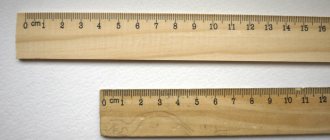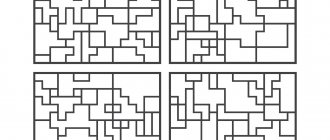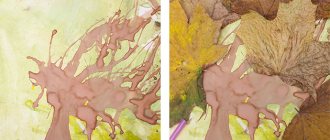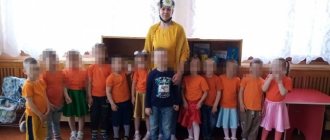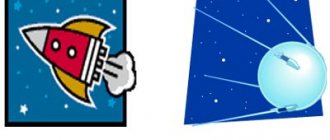Teaching older preschoolers to solve arithmetic problems
Bibliographic description:
Avsyukevich, N. I. Teaching older preschoolers to solve arithmetic problems / N. I. Avsyukevich, I. A. Bashkatova. — Text: direct // Questions of preschool pedagogy. - 2016. - No. 3 (6). — P. 103-105. — URL: https://moluch.ru/th/1/archive/41/1258/ (access date: 02/05/2022).
... Arithmetic, especially arithmetic problems, has always been recognized as having another exceptional role in learning, namely the development of intelligence and ingenuity.
A. I. Markushevich
By the time they enter school, children should have acquired a relatively wide range of interrelated knowledge about set and number, shape and size, and learn to navigate in space and time.
In the process of mathematical and general mental development of children of senior preschool age, special attention is paid to learning to solve and compose simple arithmetic problems. In kindergarten, preparatory work is carried out to develop children's confident calculation skills in adding and subtracting single-digit numbers and rapid mental calculations with two-digit numbers in order to prepare them for learning in primary school. If in school calculations are taught by solving examples and arithmetic problems, then in the practice of preschool institutions it is customary to introduce children to arithmetic operations and the simplest calculation techniques based on simple problems, the conditions of which reflect real, mainly play and everyday situations. The condition of the problem indicates the connections between the given numbers, as well as between the data and the required ones. These connections determine the choice of arithmetic operation.
Having established these connections, the child quite easily comes to understand the meaning of arithmetic operations and the meaning of the concepts “add”, “subtract”, “get”, “remain”. By solving problems, children master the ability to find relationships between quantities.
At the same time, tasks are one of the means of developing logical thinking, ingenuity, and ingenuity in children. In working with tasks, the skills of analyzing and synthesizing, generalizing and concretizing, revealing the main thing, highlighting the main thing in the text of the problem and discarding the unimportant and secondary are improved.
Simple tasks , i.e. tasks that can be solved with one action, are usually divided into the following groups:
The first group includes simple problems in which children learn the specific meaning of each arithmetic operation, i.e., which arithmetic operation corresponds to a particular operation on sets (addition or subtraction). These problems involve finding the sum of two numbers and finding the remainder.
The teacher forms ideas about the operations of addition and subtraction, and at the same time introduces children to the signs “+”, “-”, “=”. Thus, children gradually move from actions with concrete sets to actions with numbers - solving arithmetic problems and becoming familiar with notating the model of arithmetic operations using mathematical symbols.
Already in the 2nd-3rd lesson, where visual material was used, children are asked to solve oral text problems. To master the algorithm of action, exercises in independently composing tasks are useful.
4 + 2 = 6
The second group includes simple problems, when solving which it is necessary to comprehend the connection between the components and results of arithmetic operations. These are tasks to find unknown components:
a) finding the first term from the known sum and the second term.
b) finding the second term using the known sum and the first term.
c) finding the minuend from the known subtrahend and difference.
d) finding the subtrahend from the known minuend and difference.
These problems help reinforce knowledge of the structure of a problem and develop the ability to find the appropriate arithmetic operation. To help children remember numerical data better, cards with numbers, and subsequently with signs, are used.
9–3 = 6
The third group includes simple problems related to the concept of difference in ratios:
a) increasing the number by several units.
b) decreasing the number by several units.
In these problems, arithmetic operations are, as it were, prompted by the very conditions of the problem. A ratio greater than one requires the child to increase, count, add, a ratio less than one requires decrease, subtraction.
Depending on the visual material used to compose the tasks, they are divided into dramatization tasks and illustration tasks. Each type of these tasks has its own characteristics and reveals certain aspects to children, and also contributes to the development of the ability to select the necessary life, everyday, and play material for the plot of the task, and teaches them to think logically.
The peculiarity of dramatization tasks is that their content directly reflects the life of the children themselves, that is, what they just did or usually do. In dramatization tasks their meaning is most clearly revealed. Children begin to understand that the problem always reflects the specific lives of people.
The ability to think about how the content of a problem corresponds to real life contributes to a deeper knowledge of life and teaches children to consider phenomena in diverse connections, including quantitative relationships.
Problems of this type are especially valuable at the first stage of learning: children learn to compose problems about themselves, talk about each other’s actions, pose a question for solution, therefore the structure of the problem using the example of dramatization problems is most accessible to children.
A special place in the system of visual aids is occupied by tasks - illustrations. In these tasks, with the help of toys, space is created for a variety of plots. These tasks develop imagination, stimulate memory and the ability to independently come up with problems, and therefore lead to solving and composing oral problems.
Pictures are widely used to illustrate problems. The main requirements for them are simplicity of plot, dynamism of content and clearly expressed quantitative relationships between objects.
The teacher himself can create a picture task. These visual aids help to understand the meaning of an arithmetic problem and its structure.
After children have formed ideas and some concepts about an arithmetic problem, about the relationships between numerical data, between the condition and question of the problem, you can move on to familiarize yourself with the transformation of direct problems into inverse ones . This helps to better understand the specifics of each type of task. The teacher explains: any arithmetic problem can be transformed into a new one if the resulting required is considered one of the data of the new task, and one of the data of the transformed task is considered the desired one.
An example task for teaching children to solve problems in their heads.
The teacher hangs cards with tasks - pictures on which the conditions of four tasks are presented using depicted objects and arithmetic signs.
3 pears - 1 pear
2 pears+1 pear
2 berries+1 berry
3 berries - 1 berry
Choose from four picture problems the one whose solution will correspond to the given value.
1 task. The value is set to 3 pears. Which picture task is appropriate? What action should you perform in this task?
Task 2. The value is set to 2 berries. Which picture task is appropriate? What action should you perform in this task?
3 task. The teacher offers to find among the laid out picture cards those that correspond to the answer.
4 task. Try to come up with similar problems using picture cards. Children come up with the condition of the problem, tell how it should be solved, and, using cards with numbers and arithmetic signs, post the answer in an empty cell of the picture card.
An example task for introducing children to problems involving the relation “more (less) by several units.”
Problem: “Mom put 2 spoons of sugar in the car’s cup of tea, and 1 spoon more sugar in dad’s big cup. How many spoons of sugar did mom put in dad’s cup?” What is this problem about? Repeat her condition. What is asked in this problem? What needs to be done to solve the problem? There are 2 spoons of sugar in a Mashina cup - this is the first set. How many spoons of sugar are in dad's cup is unknown. This is the second set. But it is known that Dad’s cup has 1 spoon of sugar more than Masha’s cup. We need to determine the amount of sugar in the second set. There is as much sugar in dad's cup as in the first set, and one more spoon. What action will we use to solve the problem? How do we answer the problem question? Write down the solution to the problem in your notebooks using numbers and arithmetic symbols.
Familiarization with simple and inverse problems increases cognitive activity and develops the ability to think logically.
Key terms
(automatically generated)
: task, child, spoon of sugar, daddy's cup, arithmetic task, action, what action, what picture task, visual material, example task.
Types of arithmetic problems used in working with preschoolers
Svetlana Zavrazhina
Types of arithmetic problems used in working with preschoolers
When studying mathematics in preschool educational institutions, the most difficult issue for children is problem . What does it mean to solve a problem ? Solving a problem means : understanding the condition, identifying which quantities in the problem are known , which ones need to be found. How are they interconnected? Based on this, choose the right arithmetic operation , write down the corresponding example, calculate it and write down the answer.
Thus, solving the problem includes the following elements:
-analysis of the problem , highlighting known quantities and the one that needs to be found,
- a brief statement of the problem ,
-analysis of the problem , correct choice of arithmetic operation ,
-recording of the decision,
-checking the solution.
There are simple tasks (in one action)
and compound
(in two or more actions)
.
In the preparatory group of kindergarten (6-7 years old),
you can introduce children to the following types of simple
problems :
1. Finding a sum.
2. To find the remainder.
3. To increase the number by several units.
4. To reduce the number by several units.
5. To find the unknown term.
Simple problems , i.e. problems solved by one action (addition or subtraction), are divided into several groups:
1) Simple problems , when solving which children learn the specific meaning of each arithmetic operation . These are problems on finding the sum of two numbers and finding the remainder.
“Masha had one doll, she was given another doll. How many dolls does Masha have?
“There were 2 apples on the table. Vanya ate one apple. How many apples are left on the table?
2) Simple problems , when solving which you need to understand the connection between the components and results of arithmetic operations . These are tasks to find unknown components:
a) finding the first term from a known sum and the second term.
“Olya sculpted several mushrooms and a bear from plasticine, and in total she sculpted 8 figures. How many fungi did Olya sculpt?
b) finding the second term from the known sum and the first term
“Vitya sculpted 1 bear and several bunnies. In total he sculpted 7 figures. How many bunnies did Vitya sculpt?
c) finding the minuend from the known subtrahend and difference
“The children made several garlands for the Christmas tree. One of them has already been hung on the Christmas tree. They have 3 garlands left. How many garlands did the children make?
d) finding the subtrahend from the known minuend and difference
“The children made 8 garlands for the Christmas tree. When they hung several garlands on the tree, they only had one garland left. How many garlands did you hang on the tree?
6. Simple problems related to the concept of difference ratios:
a) increase the number by several units
“Misha made 6 carrots, and Katya made 1 more. How many carrots did Katya make?”
b) decreasing the number by several units
“Masha washed 4 cups, and Tanya washed 1 cup less. How many cups did Tanya wash?”
Depending on used to compose the tasks , they are divided into dramatization tasks and illustration tasks .
The peculiarities of dramatization tasks are that their content directly reflects the life of the children themselves, that is, what they just did or usually do. Children begin to understand that tasks always reflect the specific lives of people.
In illustration tasks, with the help of toys, space is created for a variety of plots and for the play of imagination:
“On the table on the left there are 5 planes, and on the right there are 3 planes. How many planes are on the table?
These tasks develop imagination. They stimulate memory and the ability to independently come up with problems , and therefore lead to solving and composing oral problems . Various pictures can be used to illustrate tasks
For example: “The picture shows 3 cars and 1 truck.”
With this data, you can create 1-2 versions of simple tasks .
